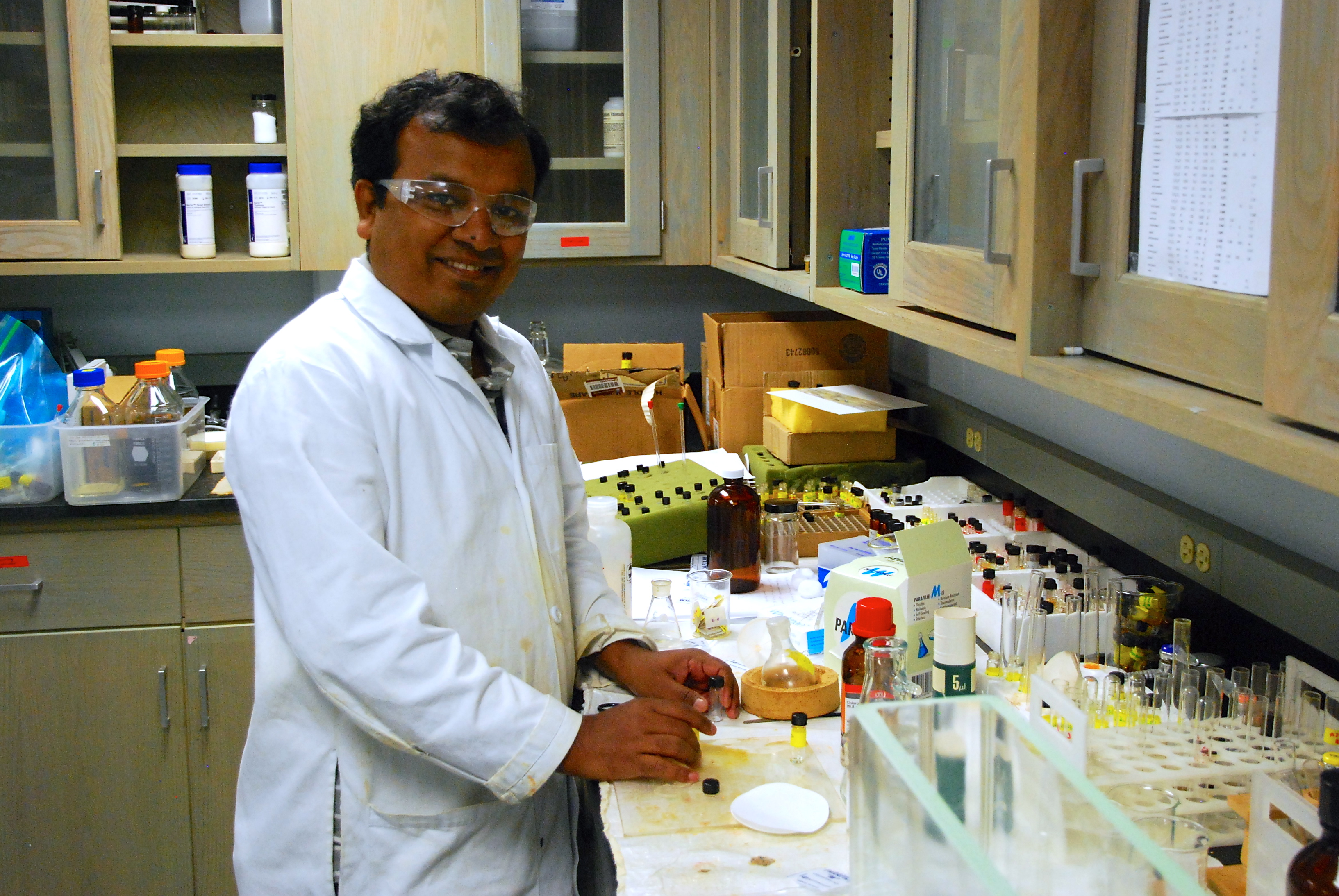Arif's Research project
Graduated in August 2013 and Joined the Ph.D. Program in the Department of Chemistry at Iowa State University , Ames, Iowa.
Synthesis of New Schiff Bases from 2,9-Phenanthroline-1,10-Dialdehyde

Arif’s Research Focus:
There is a continuing interest in the design and synthesis of molecules that efficiently bind to DNA and cleave it. In particular, the study of organic chelating agents containing nitrogen and sulfur as the donor atoms and their metal complexes has become a subject of intensive investigation. In this regard, the use of bidentate N,N chelating agents such as 1, 10-phenanthroline (phen) has played an important role in synthetic and medicinal chemistry [1]. 1,10-Phenanthroline has also been used extensively as a ligand in both analytical and preparative coordination chemistry as well as in the preparation of many mixed-ligand complexes [2]. 1,10- Phenanthroline and ligands derived from it as well as some of their metal complexes have also been found to be widely used in areas such as molecular catalysis, solar energy conversion, calorimetric analysis, herbicides, molecular recognition, self-assembly, antineoplastic agents, and nucleic acid probes [3]. It has been found that Schiff bases formed by condensation of S-alkyl/aryl esters of dithiocarbazaic acid with heterocyclic aldehydes and ketones contain both ‘hard’ nitrogen and ‘soft’ sulfur donor atoms [4]. Consequently, they are capable of forming stable complexes with a wide vriety of metal ions, some of which have also been found to exhibit interesting physico-chemical properties and potentially useful chemotherapeutic properties [5].
It has also been reported that polymeric metalcomplexes of 1,10-phenanthroline-based liands containing bithiazole rings exhibit significant magnetic properties [6]. Since organic and polymeric magnets offer advantages over traditional magnets because of the diversity of their structures, low density, low magnetic loss and process of preparation without metallurgy at high temperature, studies involving the synthesis of Schiff bases using 1,10-phenanthroline-2,9-dicarboxaldehyde and sulfur-containing primary amines deserve more attention. We, therefore, have undertaken the synthesis and characterization new Schiff bases formed from 1,10-phenanthroline-2,9-dialdehyde and some sulfur-containing amines and study their antibacterial property.
Publications:
1] Synthesis of Schiff bases from 2,2'-dipyridyl-5,5'-dialdehyde with thiocarbazates. Md. Rejaul Hoq, Mohammad R. Karim, Md. Arifuzzaman, Aminul H.Mirza. International Journal of Organic Chemistry, 2015, 5, 29-36.
2] Zn(II) Catalyzed Efficient Synthesis of 1,3,4-Oxadiazole and 1,3,4-Thiadiazole. Md. A. Rahman, Mohammad R. Karim**, Md. Arifuzzaman, Tasneem A. Siddiquee*, Aminul H. Mirza. Tetrahedron Letters, 2014, 55, 3267-73.
3] Synthesis, spectroscopy and X-ray crystal structures of some zinc(II) and cadmium(II) complexes of the 2-pyridinecarboxaldehyde Schiff bases of S-methyl- and S-benzyldithiocarbazates. Aminul Huq Mirza, Malai Haniti S.A. Hamid, Sazwani Aripin, Mohammad Rezaul Karim, Md. Arifuzzaman, Mohammad Akbar Ali, Paul V. Bernhardt. Polyhedron, 2014, 74, 16-23.
4] 2,9-Bis(5-sulfanylidene-4,5-dihydro-1,3,5-oxadiazol-2-yl)-1,10phenanthroline dimethyl sulfoxide disolvate. Md. A. Rahman, Mohammad Karim*, Md. Arifuzzaman, Tasneem Siddiquee and Lee M. Daniels. Acta Cryst. (2014), E70, 0321-0322.
5 ] Synthesis and structure of dimeric Copper (I) complex from bis[(2,2’)-Dimethyl 2,2’-(1,10- Phenanthroline 2,9-diyl)bis (methan-1-yl-1- ylidene)-bis(hydrazinecarbodithioate)]. Md. Arifuzzaman*, Tasneem A. Siddiquee*, Mohammad R. Karim**, Aminul H. Mirza†, Mohamad A. Ali†, Crystal Structure: Theory and Applications (CSTA), 2013, 2, 159-166.
6] Antibacterial Study of Schiff Bases derived from 1,10-Phenanthroline-2,9-dialdehyde with Sulfur-containing Amines. Md. Arifuzzaman*, Korsi Dumenyo, Mohammad R. Karim**, Aminul H. Mirza†, J of Microbiology, To be submitted, 2013
References:
- Sithambaram K. M., Jagadesh P. D., Poojary B., Subramanya B. K., Bioorg. Med. Chem., 2006,14,7482.
- Cho, J. Y., G. J. Cjoi., S. W. Lee., H. K.Y. Lim., K.S. Jang., C. H.Lim.,K. Y. Chao and J. C. Kim, 2006, In-vivo antifungal activity against against virus plant pathogenic fungai cucumonoids isolated from the rhizomes curcuma longa, Plant Path. J. 2004.
- B. Shivarama Holla, B. Sooryanarayana Rao, K. Shridhara, and P. M. Akberali, “Studies on arylfuran derivatives: part XI. Synthesis, characterization and biological studies on some Mannich bases carrying 2,4-dichlorophenylfurfural moiety, ” Farmaco, vol. 54, no.5, pp.338-344, 2000
- V. K. Chaha, N. S. Ranwa, and P. K. Dadheech, “Synthesis and screening of biological activity of triazolothiadiazines and triazolothiadiazoles,” Journal of Phytol Research, vol.11, p.201,1998
- B. H. Mehta and V. P. Vengarlekar, “UV-Visibile and IR spectral data of Pd(II) complexes derived from bidentate Schiff bases,” Asian Journal of Chemistry, vol. 11, no.2, pp.397-400, 1999.
- N. Raman, A. Kulandaisamy, A. Shunmugasundaram, and K. Jeyasubramanian, “Synthesis, spectral, redox and antimicrobial activities of Schiff base complexes derived from 1-phenyl-2,3-dimethyl-4-aminopyrazol-5-one and acetoacetanilide, ” Transition Metal Chemistry, vol. 26, no. 1-2, pp.131-135, 2001.
webpage contact:
Chemistry


